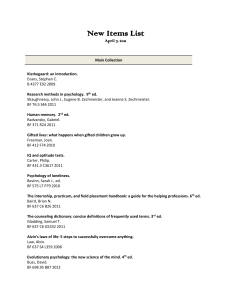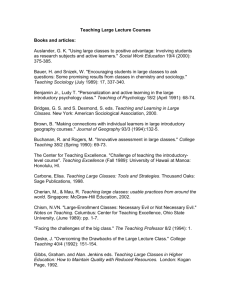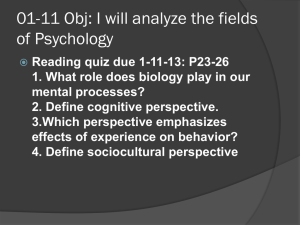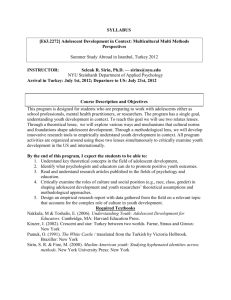Environmental Psychology at Rocky Mountain - East
advertisement
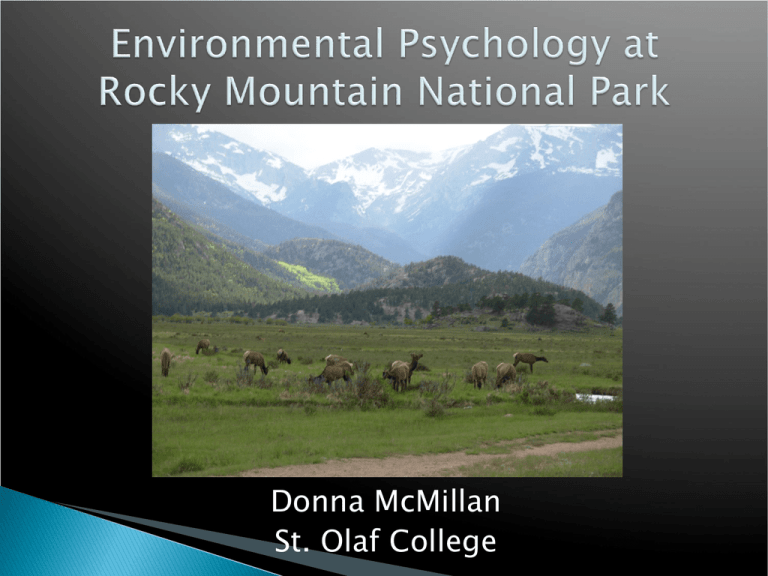
Donna McMillan St. Olaf College What does nature mean to people? What do we value about the natural world? What psychological needs are addressed in our encounters with nature? How are we affected by nature? What influences people’s attitudes and behaviors toward the environment? How have human actions affected the environment, and what can psychology offer regarding environmental problems? The Dongria Kondh, a tribe in Orissa, are opposing mining of their sacred homeland by the British Vedanta aluminum company. Video (12 minutes) Mine: Story of a Sacred Mountain www.survivalinternational.org/films/mine Readings: Jagger, B. (June 13,2010). The battle for Niyamgiri. Guardian.co.uk. Totman, C. (2005). Asia’s environment, 1900-2000. Education About Asia, 10(2), 12-18. Industrialization vs. indigenous ways of life: Who decides what constitutes a good life? Isn’t development a good thing? The natural world: sacred ground or lucrative resource? Ecocentrism and anthropocentrism. What psychological issues are associated with environmental damage, violence, and displacement? What rights do we consider basic human rights? What interconnections exist within an ecosystem (including humans)? Sato, J. (2004). From “natural wealth” to “resources”: Simplification of nature in Asia. In T. Sasaki (Ed.). Nature and human communities (pp. 111-122). Tokyo: Springer. Komiyama, H., & Osawa, T. (2004). Global sustainability and the role of Asia. In T. Sasaki (Ed.). Nature and human communities (pp. 187-216). Tokyo: Springer. Bruun, O., & Kalland, A. (1995). Images of nature: An introduction to the study of man-environment relations in Asia. In O. Bruun & A. Kalland (Eds.). Asian perceptions of nature: A critical approach (pp. 2-24). Curzon Press. Husain, Z. (Ed.). (2003). Environmental issues of north east India. New Delhi: Regency Publications. Hendry, J. (1997). Nature tamed: Gardens as a microcosm of Japan’s view of the world. In P.M. Asquith & A. Kalland (Eds.) Japanese images of nature: Cultural perspectives (pp.83-105). Curzon Press. Miri, S. (2001). Ethics and environment. Delhi: Spectrum Publications. Hershock, P. D. (2009). Liberating environments. Buddhism in the public sphere: Reorienting global interdependence (pp. 13-38). Routledge. Tucker, M.E., & Williams, D.R. (1998). Buddhism and ecology: The interconnection of dharma and deeds. Harvard University Press. Ramanujam, G. (2006). Environmental awareness in Jainism. Chennai: University of Madras. Chapple, C.K. (Ed.) (2002). Jainism and ecology: Nonviolence in the web of life. Harvard University Press. Chapple, C.K., & Tucker, M.E. (Eds.). (2000). Hinduism and ecology: The intersection of earth, sky, and water. Center for the Study of World Religions. Das, R.K. (2004). Examining the traditional tribal way of maintaining a balance between society and environment. In M. Desai & M.K. Raha (Eds.). The dying earth: People’s action and nature’s reaction (pp. 438-446). Kolkata: ACB Publications. Chowdhuri, M.K. (2004). Primitive tribes in a changing environment. In M. Desai & M.K. Raha (Eds.). The dying earth: People’s action and nature’s reaction (pp. 427-437). Kolkata: ACB Publications. Sarkar, A., & Dasgupta, S. (2000). Ethno-ecology of Indian tribes: Diversity in cultural adaptation. Jaipur: Rawat Publications. Chowdury, A.N., & Weiss, M.G. (2004). Eco-stress and mental health in Sundarban Delta, India. In M. Desai & M.K. Raha (Eds.). The dying earth: People’s action and nature’s reaction (pp. 108-119). Kolkata: ACB Publications. Personality Psychology reading: Brazier, D. (2002). The feeling Buddha: A Buddhist psychology of character, adversity, and passion. Palgrave Macmillan. Positive Psychology reading: Levine, M. (2009). The positive psychology of Buddhism and yoga: Paths to a mature happiness, 2nd ed. Routledge. Abnormal Psychology reading & discussion: Tsutsui, W.M. (2008). Nerd nation: Otaku and youth subcultures in contemporary Japan. Education About Asia, 13(3), 12-18. Discussion issues include: - What is “normal” and what is “abnormal”? - Similarity to “internet addiction;” Are these behaviors psychological disorders? - To what extent does the medical model of psychopathology fit here? - Role of culture in human behavior
